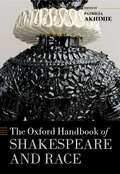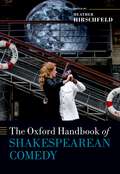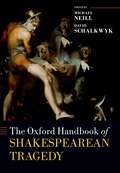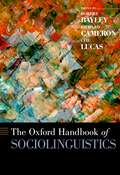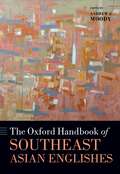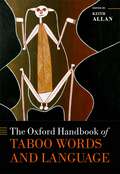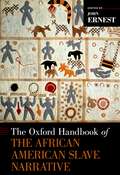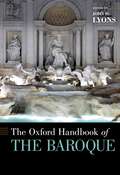- Table View
- List View
The Oxford Handbook of Shakespeare and Race (Oxford Handbooks)
by Patricia AkhimiePremodern critical race studies, long intertwined with Shakespeare studies, has broadened our understanding of the definitions and discourse of race and racism to include not only phenotype, but also religious and political identity, regional, national, and linguistic difference, and systems of differentiation based upon culture and custom. Replete with fresh readings of the plays and poems, The Oxford Handbook of Shakespeare and Race brings together some of the most important scholars thinking about the subject today. The volume offers a thorough overview of the most significant theoretical and methodological paradigms such as critical race theory, feminist, and postcolonial studies; a dynamic look at intersections of race with queer, trans, disability, and indigenous studies; and a vibrant array of new approaches from ecocriticism, to animality, and human rights, from book history, to scholarly editing, and repertory studies; and an exploration of Shakespeare and race in our contemporary moment through discussions of political activism, pedagogy, visual arts, film, and theatre. Woven through the collection are the voices of practicing theatre professionals who have grappled with the challenges of race and racism both in performance and in the profession itself.
The Oxford Handbook of Shakespeare and Race (Oxford Handbooks)
by Patricia AkhimiePremodern critical race studies, long intertwined with Shakespeare studies, has broadened our understanding of the definitions and discourse of race and racism to include not only phenotype, but also religious and political identity, regional, national, and linguistic difference, and systems of differentiation based upon culture and custom. Replete with fresh readings of the plays and poems, The Oxford Handbook of Shakespeare and Race brings together some of the most important scholars thinking about the subject today. The volume offers a thorough overview of the most significant theoretical and methodological paradigms such as critical race theory, feminist, and postcolonial studies; a dynamic look at intersections of race with queer, trans, disability, and indigenous studies; and a vibrant array of new approaches from ecocriticism, to animality, and human rights, from book history, to scholarly editing, and repertory studies; and an exploration of Shakespeare and race in our contemporary moment through discussions of political activism, pedagogy, visual arts, film, and theatre. Woven through the collection are the voices of practicing theatre professionals who have grappled with the challenges of race and racism both in performance and in the profession itself.
The Oxford Handbook of Shakespearean Comedy (Oxford Handbooks)
by Heather HirschfeldThe Oxford Handbook of Shakespearean Comedy offers critical and contemporary resources for studying Shakespeare's comic enterprises. It engages with perennial, yet still urgent questions raised by the comedies and looks at them from a range of new perspectives that represent the most recent methodological approaches to Shakespeare, genre, and early modern drama. Several chapters take up firmly established topics of inquiry such Shakespeare's source materials, gender and sexuality, hetero- and homoerotic desire, race, and religion, and they reformulate these topics in the materialist, formalist, phenomenological, or revisionist terms of current scholarship and critical debate. Others explore subjects that have only relatively recently become pressing concerns for sustained scholarly interrogation, such as ecology, cross-species interaction, and humoral theory. Some contributions, informed by increasingly sophisticated approaches to the material conditions and embodied experience of theatrical practice, speak to a resurgence of interest in performance, from Shakespeare's period through the first decades of the twenty-first century. Others still investigate distinct sets of plays from unexpected and often polemical angles, noting connections between the comedies under inventive, unpredicted banners such as the theology of adultery, early modern pedagogy, global exploration, or monarchical rule. All the chapters offer contemporary perspectives on the plays even as they gesture to critical traditions, and they illuminate as well as challenge some of our most cherished expectations about the ways in which Shakespearean comedy affects its audiences. The Handbook situates these approaches against the long history of criticism and provides a valuable overview of the most up-to-date work in the field.
The Oxford Handbook of Shakespearean Tragedy (Oxford Handbooks)
by Michael Neill and David SchalkwykThe Oxford Handbook of Shakespearean Tragedy presents fifty-four essays by a range of scholars from all parts of the world. Together these essays offer readers a fresh and comprehensive understanding of Shakespeare tragedies as both works of literature and as performance texts written by a playwright who was himself an experienced actor. The opening section explores ways in which later generations of critics have shaped our idea of 'Shakespearean' tragedy, and addresses questions of genre by examining the playwright's inheritance from the classical and medieval past. The second section is devoted to current textual issues, while the third offers new critical readings of each of the tragedies. This is set beside a group of essays that deal with performance history, with screen productions, and with versions devised for the operatic stage, as well as with twentieth and twenty-first century re-workings of Shakespearean tragedy. The book's final section expands readers' awareness of Shakespeare's global reach, tracing histories of criticism and performance across Europe, the Americas, Australasia, the Middle East, Africa, India, and East Asia.
The Oxford Handbook of Shakespearean Tragedy (Oxford Handbooks)
The Oxford Handbook of Shakespearean Tragedy presents fifty-four essays by a range of scholars from all parts of the world. Together these essays offer readers a fresh and comprehensive understanding of Shakespeare tragedies as both works of literature and as performance texts written by a playwright who was himself an experienced actor. The opening section explores ways in which later generations of critics have shaped our idea of 'Shakespearean' tragedy, and addresses questions of genre by examining the playwright's inheritance from the classical and medieval past. The second section is devoted to current textual issues, while the third offers new critical readings of each of the tragedies. This is set beside a group of essays that deal with performance history, with screen productions, and with versions devised for the operatic stage, as well as with twentieth and twenty-first century re-workings of Shakespearean tragedy. The book's final section expands readers' awareness of Shakespeare's global reach, tracing histories of criticism and performance across Europe, the Americas, Australasia, the Middle East, Africa, India, and East Asia.
The Oxford Handbook of Sociolinguistics (Oxford Handbooks)
From its beginnings in the 1960s, sociolinguistics developed several different subfields with distinct methods and interests: the variationist tradition established by Labov, the anthropological tradition of Hymes, interactional sociolinguistics as developed by Gumperz, and the sociology of language represented by the work of Fishman. All of these areas have seen a great deal of growth in recent decades, and recent studies have led to a more broadly inclusive view of sociolinguistics. Hence there is a need for a handbook that will survey the main areas of the field, point out the lacunae in our existing knowledge base, and provide directions for future research. The Oxford Handbook of Sociolinguistics will differ from existing work in four major respects. First, it will emphasize new methodological developments, particularly the convergence of linguistic anthropology and variationist sociolinguistics. Second, it will include chapters on sociolinguistic developments in areas of the world that have been relatively neglected in the major journals. Third, its chapters are written by contributors who have worked in a range of languages and whose work addresses sociolinguistic issues in bi- and multilingual contexts, i.e. the contexts in which a majority of the world's population lives. Finally, it will include substantial material on the rapidly growing study of sign language sociolinguistics.
The Oxford Handbook of Southeast Asian Englishes (Oxford Handbooks)
by Andrew J. MoodyThe Oxford Handbook of Southeast Asian Englishes is the first reference work of its kind to describe both the history and the contemporary forms, functions, and status of English in Southeast Asia (SEA). Since the arrival of English traders to Southeast Asia in the seventeenth century, the English language has had a profound impact on the linguistic ecologies and the development of societies throughout the region. Today, countries such as Singapore and the Philippines have adopted English as a national language, while in others, such as Indonesia and Cambodia, it is used as a foreign language of education. The chapters in this volume provide a comprehensive overview of current research on a wide range of topics, addressing the impact of English as a language of globalization and exploring new approaches to the spread of English in SEA. The volume is divided into six parts that investigate, respectively: historical and contemporary English contact in SEA; the structures of the Englishes spokes in different SEA nations; the English-language literatures of the region; approaches to English in education throughout the region; and resources for researching SEA Englishes. The handbook will be an invaluable reference work for students and researchers in areas as diverse as contact linguistics, English as a Foreign Language, world Englishes, and sociolinguistics.
The Oxford Handbook of Southeast Asian Englishes (Oxford Handbooks)
The Oxford Handbook of Southeast Asian Englishes is the first reference work of its kind to describe both the history and the contemporary forms, functions, and status of English in Southeast Asia (SEA). Since the arrival of English traders to Southeast Asia in the seventeenth century, the English language has had a profound impact on the linguistic ecologies and the development of societies throughout the region. Today, countries such as Singapore and the Philippines have adopted English as a national language, while in others, such as Indonesia and Cambodia, it is used as a foreign language of education. The chapters in this volume provide a comprehensive overview of current research on a wide range of topics, addressing the impact of English as a language of globalization and exploring new approaches to the spread of English in SEA. The volume is divided into six parts that investigate, respectively: historical and contemporary English contact in SEA; the structures of the Englishes spokes in different SEA nations; the English-language literatures of the region; approaches to English in education throughout the region; and resources for researching SEA Englishes. The handbook will be an invaluable reference work for students and researchers in areas as diverse as contact linguistics, English as a Foreign Language, world Englishes, and sociolinguistics.
The Oxford Handbook of Soviet Underground Culture (Oxford Handbooks)
by Mark Lipovetsky, Maria Engström, Tomáš Glanc, Ilja Kukuj, Klavdia SmolaIn 1932, the Central Committee of the Communist Party issued the resolution "On the Restructuring of Literary and Arts Organizations." This resolution put an end to the coexistence of aesthetically different groups and associations of writers and artists that had been common during the 1920s, and instead, led to the establishment of the monopoly of Socialist Realism in 1934. Ironically, this resolution unwittingly created a rich literary and artistic production of underground intellectuals, known as the Soviet underground, during an era of political and aesthetic censorship in the Soviet Union. The Oxford Handbook of Soviet Underground Culture is the first comprehensive English-language volume covering a history of Soviet artistic and literary underground. In forty-four chapters, an international group of leading scholars introduce readers to a web of subcultures within the underground, highlight the culture achievements of the Soviet underground from the 1930s through the 1980s, emphasize the multimediality of this cultural phenomenon, and situate the study of underground literary texts and artworks into their broader theoretical, ideological, and political contexts. The volume presents readers with several approaches to mapping the underground that include chapters on nonconformist cultures in Ukraine, Belarus, Baltic countries, Central Asia, and provincial cities of Russian Federation. Finally, the volume also provides an analysis of groups shaped around religious and cultural identity, as well as queer and feminist underground circles.
The Oxford Handbook of Soviet Underground Culture (Oxford Handbooks)
In 1932, the Central Committee of the Communist Party issued the resolution "On the Restructuring of Literary and Arts Organizations." This resolution put an end to the coexistence of aesthetically different groups and associations of writers and artists that had been common during the 1920s, and instead, led to the establishment of the monopoly of Socialist Realism in 1934. Ironically, this resolution unwittingly created a rich literary and artistic production of underground intellectuals, known as the Soviet underground, during an era of political and aesthetic censorship in the Soviet Union. The Oxford Handbook of Soviet Underground Culture is the first comprehensive English-language volume covering a history of Soviet artistic and literary underground. In forty-four chapters, an international group of leading scholars introduce readers to a web of subcultures within the underground, highlight the culture achievements of the Soviet underground from the 1930s through the 1980s, emphasize the multimediality of this cultural phenomenon, and situate the study of underground literary texts and artworks into their broader theoretical, ideological, and political contexts. The volume presents readers with several approaches to mapping the underground that include chapters on nonconformist cultures in Ukraine, Belarus, Baltic countries, Central Asia, and provincial cities of Russian Federation. Finally, the volume also provides an analysis of groups shaped around religious and cultural identity, as well as queer and feminist underground circles.
The Oxford Handbook of Taboo Words and Language (Oxford Handbooks)
by Keith AllanThis volume brings together experts from a wide range of disciplines to define and describe tabooed words and language and to investigate the reasons and beliefs behind them. In general, taboo is defined as a proscription of behaviour for a specific community, time, and context. In terms of language, taboo applies to instances of language behaviour: the use of certain words in certain contexts. The existence of linguistic taboos and their management lead to the censoring of behaviour and, as a consequence, to language change and development. Chapters in this volume explore the multiple types of tabooed language from a variety of perspectives, such as sociolinguistics, anthropology, philosophy, psychology, historical linguistics, and neurolinguistics, and with reference to fields such as law, publishing, politics, and advertising. Topics covered include impoliteness, swearing, censorship, taboo in deaf communities, translation of tabooed words, and the use of taboo in banter and comedy.
The Oxford Handbook of Taboo Words and Language (Oxford Handbooks)
This volume brings together experts from a wide range of disciplines to define and describe tabooed words and language and to investigate the reasons and beliefs behind them. In general, taboo is defined as a proscription of behaviour for a specific community, time, and context. In terms of language, taboo applies to instances of language behaviour: the use of certain words in certain contexts. The existence of linguistic taboos and their management lead to the censoring of behaviour and, as a consequence, to language change and development. Chapters in this volume explore the multiple types of tabooed language from a variety of perspectives, such as sociolinguistics, anthropology, philosophy, psychology, historical linguistics, and neurolinguistics, and with reference to fields such as law, publishing, politics, and advertising. Topics covered include impoliteness, swearing, censorship, taboo in deaf communities, translation of tabooed words, and the use of taboo in banter and comedy.
The Oxford Handbook of Tense and Aspect (Oxford Handbooks)
Tense and aspect are means by which language refers to time--how an event takes place in the past, present, or future. They play a key role in understanding the grammar and structure of all languages, and interest in them reaches across linguistics. The Oxford Handbook of Tense and Aspect is a comprehensive, authoritative, and accessible guide to the topics and theories that currently form the front line of research into tense, aspect, and related areas. The volume contains 36 chapters, divided into 6 sections, written by internationally known experts in theoretical linguistics.
The Oxford Handbook of the African American Slave Narrative (Oxford Handbooks)
by John ErnestGiven the rise of new interdisciplinary and methodological approaches to African American and Black Atlantic studies, The Oxford Handbook of the African American Slave Narrative will offer a fresh, wide-ranging assessment of this major American literary genre. The volume will begin with articles that consider the fundamental concerns of gender, sexuality, community, and the Christian ethos of suffering and redemption that are central to any understanding of slave narratives. The chapters that follow will interrogate the various agendas behind the production of both pre- and post-Emancipation narratives and take up the various interpretive problems they pose. Strategic omissions and veiled gestures were often necessary in these life accounts as they revealed disturbing, too-painful truths, far beyond what white audiences were prepared to hear. While touching upon the familiar canonical autobiographies of Frederick Douglass and Harriet Jacobs, the Handbook will pay more attention to the under-studied narratives of Josiah Henson, Sojourner Truth, William Grimes, Henry Box Brown, and other often-overlooked accounts. In addition to the literary autobiographies of bondage, the volume will anatomize the powerful WPA recordings of interviews with former slaves during the late 1930s. With essays on the genre's imaginative afterlife, its final essays will chart the emergence and development of neoslave narratives, most notably in Styron's The Confessions of Nat Turner, Toni Morrisons's Beloved and Octavia Butler's provocative science fiction novel, Kindred. In short, the Handbook will provide a long-overdue assessment of the state of the genre and the vital scholarship that continues to grow around it, work that is offering some of the most provocative analysis emerging out of the literary studies discipline as a whole.
The Oxford Handbook of the Age of Shakespeare (Oxford Handbooks)
by R. Malcolm SmutsThe Oxford Handbook of the Age of Shakespeare presents a broad sampling of current historical scholarship on the period of Shakespeare's career that will assist and stimulate scholars of his poems and plays. Rather than merely attempting to summarize the historical 'background' to Shakespeare, individual chapters seek to exemplify a wide variety of perspectives and methodologies currently used in historical research on the early modern period that can inform close analysis of literature. Different sections examine political history at both the national and local levels; relationships between intellectual culture and the early modern political imagination; relevant aspects of religious and social history; and facets of the histories of architecture, the visual arts, and music. Topics treated include the emergence of an early modern 'public sphere' and its relationship to drama during Shakespeare's lifetime; the role of historical narratives in shaping the period's views on the workings of politics; attitudes about the role of emotion in social life; cultures of honour and shame and the rituals and literary forms through which they found expression; crime and murder; and visual expressions of ideas of moral disorder and natural monstrosity, in printed images as well as garden architecture.
The Oxford Handbook of the Age of Shakespeare (Oxford Handbooks)
The Oxford Handbook of the Age of Shakespeare presents a broad sampling of current historical scholarship on the period of Shakespeare's career that will assist and stimulate scholars of his poems and plays. Rather than merely attempting to summarize the historical 'background' to Shakespeare, individual chapters seek to exemplify a wide variety of perspectives and methodologies currently used in historical research on the early modern period that can inform close analysis of literature. Different sections examine political history at both the national and local levels; relationships between intellectual culture and the early modern political imagination; relevant aspects of religious and social history; and facets of the histories of architecture, the visual arts, and music. Topics treated include the emergence of an early modern 'public sphere' and its relationship to drama during Shakespeare's lifetime; the role of historical narratives in shaping the period's views on the workings of politics; attitudes about the role of emotion in social life; cultures of honour and shame and the rituals and literary forms through which they found expression; crime and murder; and visual expressions of ideas of moral disorder and natural monstrosity, in printed images as well as garden architecture.
The Oxford Handbook of the Baroque (Oxford Handbooks)
by John D. LyonsFew periods in history are so fundamentally contradictory as the Baroque, the culture flourishing from the mid-sixteenth to the mid-eighteenth centuries in Europe. When we hear the term âBaroque,â the first images that come to mind are symmetrically designed gardens in French chateaux, scenic fountains in Italian squares, and the vibrant rhythms of a harpsichord. Behind this commitment to rule, harmony, and rigid structure, however, the Baroque also embodies a deep fascination with wonder, excess, irrationality, and rebellion against order. The Oxford Handbook of the Baroque delves into this contradiction to provide a sweeping survey of the Baroque not only as a style but also as a historical, cultural, and intellectual concept. With its thirty-eight chapters edited by leading expert John D. Lyons, the Handbook explores different manifestations of Baroque culture, from theatricality in architecture and urbanism to opera and dance, from the role of water to innovations in fashion, from mechanistic philosophy and literature to the tension between religion and science. These discussions present the Baroque as a broad cultural phenomenon that arose in response to the enormous changes emerging from the sixteenth century: the division between Catholics and Protestants, the formation of nation-states and the growth of absolutist monarchies, the colonization of lands outside Europe and the mutual impact of European and non-European cultures. Technological developments such as the telescope and the microscope and even greater access to high-quality mirrors altered mankindâs view of the universe and of human identity itself. By exploring the Baroque in relation to these larger social upheavals, this Handbook reveals a fresh and surprisingly modern image of the Baroque as a powerful response to an epoch of crisis.
The Oxford Handbook of the Baroque (Oxford Handbooks)
by John D. LyonsFew periods in history are so fundamentally contradictory as the Baroque, the culture flourishing from the mid-sixteenth to the mid-eighteenth centuries in Europe. When we hear the term âBaroque,â the first images that come to mind are symmetrically designed gardens in French chateaux, scenic fountains in Italian squares, and the vibrant rhythms of a harpsichord. Behind this commitment to rule, harmony, and rigid structure, however, the Baroque also embodies a deep fascination with wonder, excess, irrationality, and rebellion against order. The Oxford Handbook of the Baroque delves into this contradiction to provide a sweeping survey of the Baroque not only as a style but also as a historical, cultural, and intellectual concept. With its thirty-eight chapters edited by leading expert John D. Lyons, the Handbook explores different manifestations of Baroque culture, from theatricality in architecture and urbanism to opera and dance, from the role of water to innovations in fashion, from mechanistic philosophy and literature to the tension between religion and science. These discussions present the Baroque as a broad cultural phenomenon that arose in response to the enormous changes emerging from the sixteenth century: the division between Catholics and Protestants, the formation of nation-states and the growth of absolutist monarchies, the colonization of lands outside Europe and the mutual impact of European and non-European cultures. Technological developments such as the telescope and the microscope and even greater access to high-quality mirrors altered mankindâs view of the universe and of human identity itself. By exploring the Baroque in relation to these larger social upheavals, this Handbook reveals a fresh and surprisingly modern image of the Baroque as a powerful response to an epoch of crisis.
The Oxford Handbook of the Bible in Early Modern England, c. 1530-1700 (Oxford Handbooks)
by Kevin Killeen, Helen Smith and Rachel WillieThe Bible was, by any measure, the most important book in early modern England. It preoccupied the scholarship of the era, and suffused the idioms of literature and speech. Political ideas rode on its interpretation and deployed its terms. It was intricately related to the project of natural philosophy. And it was central to daily life at all levels of society from parliamentarian to preacher, from the 'boy that driveth the plough', famously invoked by Tyndale, to women across the social scale. It circulated in texts ranging from elaborate folios to cheap catechisms; it was mediated in numerous forms, as pictures, songs, and embroideries, and as proverbs, commonplaces, and quotations. Bringing together leading scholars from a range of fields, The Oxford Handbook of the Bible in Early Modern England, 1530-1700 explores how the scriptures served as a generative motor for ideas, and a resource for creative and political thought, as well as for domestic and devotional life. Sections tackle the knotty issues of translation, the rich range of early modern biblical scholarship, Bible dissemination and circulation, the changing political uses of the Bible, literary appropriations and responses, and the reception of the text across a range of contexts and media. Where existing scholarship focuses, typically, on Tyndale and the King James Bible of 1611, The Oxford Handbook of the Bible in England, 1530-1700 goes further, tracing the vibrant and shifting landscape of biblical culture in the two centuries following the Reformation.
The Oxford Handbook of the Bible in Early Modern England, c. 1530-1700 (Oxford Handbooks)
The Bible was, by any measure, the most important book in early modern England. It preoccupied the scholarship of the era, and suffused the idioms of literature and speech. Political ideas rode on its interpretation and deployed its terms. It was intricately related to the project of natural philosophy. And it was central to daily life at all levels of society from parliamentarian to preacher, from the 'boy that driveth the plough', famously invoked by Tyndale, to women across the social scale. It circulated in texts ranging from elaborate folios to cheap catechisms; it was mediated in numerous forms, as pictures, songs, and embroideries, and as proverbs, commonplaces, and quotations. Bringing together leading scholars from a range of fields, The Oxford Handbook of the Bible in Early Modern England, 1530-1700 explores how the scriptures served as a generative motor for ideas, and a resource for creative and political thought, as well as for domestic and devotional life. Sections tackle the knotty issues of translation, the rich range of early modern biblical scholarship, Bible dissemination and circulation, the changing political uses of the Bible, literary appropriations and responses, and the reception of the text across a range of contexts and media. Where existing scholarship focuses, typically, on Tyndale and the King James Bible of 1611, The Oxford Handbook of the Bible in England, 1530-1700 goes further, tracing the vibrant and shifting landscape of biblical culture in the two centuries following the Reformation.
The Oxford Handbook of the Eighteenth-Century Novel (Oxford Handbooks)
by J. A. DownieAlthough the emergence of the English novel is generally regarded as an eighteenth-century phenomenon, this is the first book to be published professing to cover the 'eighteenth-century English novel' in its entirety. This Handbook surveys the development of the English novel during the 'long' eighteenth century-in other words, from the later seventeenth century right through to the first three decades of the nineteenth century when, with the publication of the novels of Jane Austen and Walter Scott, 'the novel' finally gained critical acceptance and assumed the position of cultural hegemony it enjoyed for over a century. By situating the novels of the period which are still read today against the background of the hundreds published between 1660 and 1830, this Handbook not only covers those 'masters and mistresses' of early prose fiction-such as Defoe, Richardson, Fielding, Sterne, Burney, Scott and Austen-who are still acknowledged to be seminal figures in the emergence and development of the English novel, but also the significant number of recently-rediscovered novelists who were popular in their own day. At the same time, its comprehensive coverage of cultural contexts not considered by any existing study, but which are central to the emergence of the novel, such as the book trade and the mechanics of book production, copyright and censorship, the growth of the reading public, the economics of culture both in London and in the provinces, and the re-printing of popular fiction after 1774, offers unique insight into the making of the English novel.
The Oxford Handbook of the Eighteenth-Century Novel (Oxford Handbooks)
Although the emergence of the English novel is generally regarded as an eighteenth-century phenomenon, this is the first book to be published professing to cover the 'eighteenth-century English novel' in its entirety. This Handbook surveys the development of the English novel during the 'long' eighteenth century-in other words, from the later seventeenth century right through to the first three decades of the nineteenth century when, with the publication of the novels of Jane Austen and Walter Scott, 'the novel' finally gained critical acceptance and assumed the position of cultural hegemony it enjoyed for over a century. By situating the novels of the period which are still read today against the background of the hundreds published between 1660 and 1830, this Handbook not only covers those 'masters and mistresses' of early prose fiction-such as Defoe, Richardson, Fielding, Sterne, Burney, Scott and Austen-who are still acknowledged to be seminal figures in the emergence and development of the English novel, but also the significant number of recently-rediscovered novelists who were popular in their own day. At the same time, its comprehensive coverage of cultural contexts not considered by any existing study, but which are central to the emergence of the novel, such as the book trade and the mechanics of book production, copyright and censorship, the growth of the reading public, the economics of culture both in London and in the provinces, and the re-printing of popular fiction after 1774, offers unique insight into the making of the English novel.
The Oxford Handbook of the French Language (Oxford Handbooks)
by Wendy Ayres-Bennett, Mairi MclaughlinThis volume provides the first comprehensive reference work in English on the French language in all its facets. It offers a wide-ranging approach to the rich, varied, and exciting research across multiple subfields, with seven broad thematic sections covering the structures of French; the history of French; axes of variation; French around the world; French in contact with other languages; second language acquisition; and French in literature, culture, arts, and the media. Each chapter presents the state of the art and directs readers to canonical studies and essential works, while also exploring cutting-edge research and outlining future directions. The Oxford Handbook of the French Language serves both as a reference work for people who are curious to know more about the French language and as a starting point for those carrying out new research on the language and its many varieties. It will appeal to undergraduate and graduate students as well as established scholars, whether they are specialists in French linguistics or researchers in a related field looking to learn more about the language. The diversity of frameworks, approaches, and scholars in the volume demonstrates above all the variety, vitality, and vibrancy of work on the French language today.
The Oxford Handbook of the French Language (Oxford Handbooks)
This volume provides the first comprehensive reference work in English on the French language in all its facets. It offers a wide-ranging approach to the rich, varied, and exciting research across multiple subfields, with seven broad thematic sections covering the structures of French; the history of French; axes of variation; French around the world; French in contact with other languages; second language acquisition; and French in literature, culture, arts, and the media. Each chapter presents the state of the art and directs readers to canonical studies and essential works, while also exploring cutting-edge research and outlining future directions. The Oxford Handbook of the French Language serves both as a reference work for people who are curious to know more about the French language and as a starting point for those carrying out new research on the language and its many varieties. It will appeal to undergraduate and graduate students as well as established scholars, whether they are specialists in French linguistics or researchers in a related field looking to learn more about the language. The diversity of frameworks, approaches, and scholars in the volume demonstrates above all the variety, vitality, and vibrancy of work on the French language today.
The Oxford Handbook of the Georgian Theatre 1737-1832 (Oxford Handbooks)
The Oxford Handbook of the Georgian Theatre 1737-1832 provides an essential guide to theatre in Britain between the passing of the Stage Licensing Act in 1737 and the Reform Act of 1832 — a period of drama long neglected but now receiving significant scholarly attention. Written by specialists from a range of disciplines, its forty essays both introduce students and scholars to the key texts and contexts of the Georgian theatre and also push the boundaries of the field, asking questions that will animate the study of drama in the eighteenth and early nineteenth centuries for years to come. The Handbook gives equal attention to the range of dramatic forms — not just tragedy and comedy, but the likes of melodrama and pantomime — as they developed and overlapped across the period, and to the occasions, communities, and materialities of theatre production. It includes sections on historiography, the censorship and regulation of drama, theatre and the Romantic canon, women and the stage, and the performance of race and empire. In doing so, the Handbook shows the centrality of theatre to Georgian culture and politics, and paints a picture of a stage defined by generic fluidity and experimentation; by networks of performance that spread far beyond London; by professional women who played pivotal roles in every aspect of production; and by its complex mediation of contemporary attitudes of class, race, and gender.
